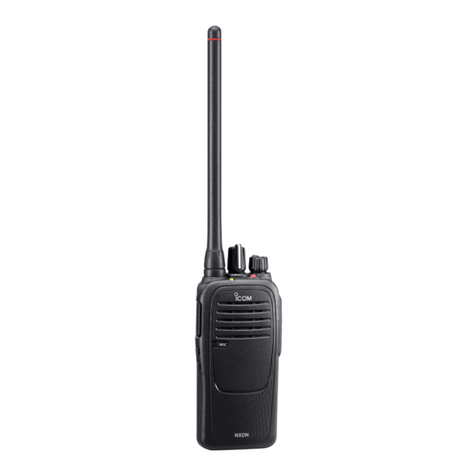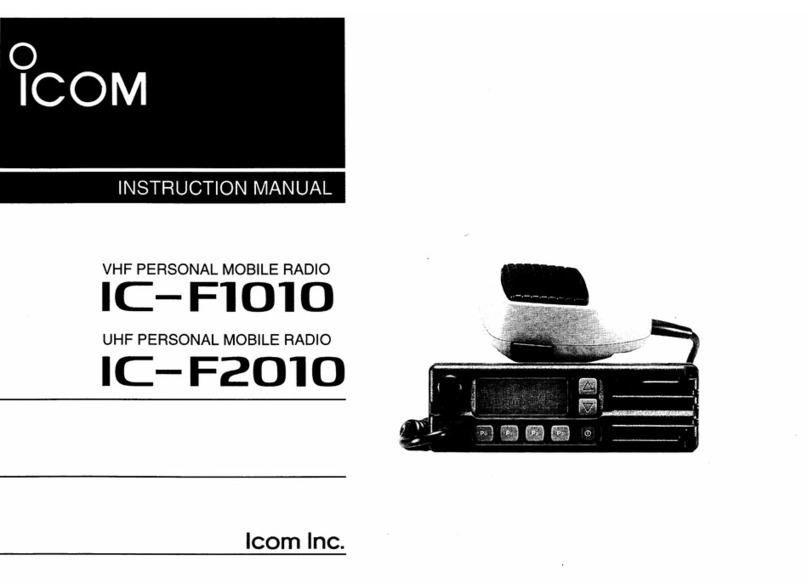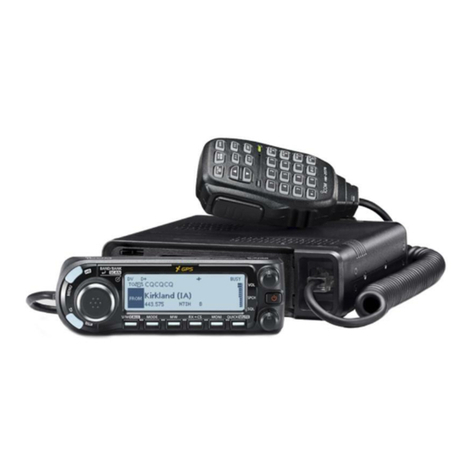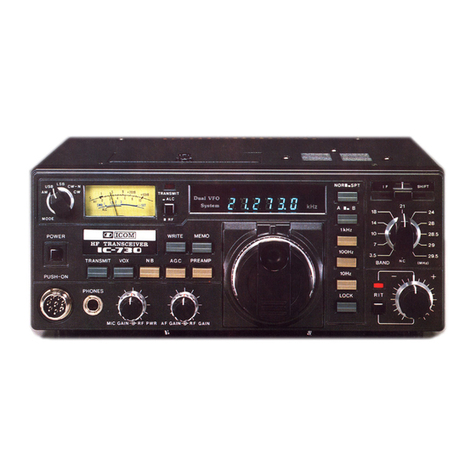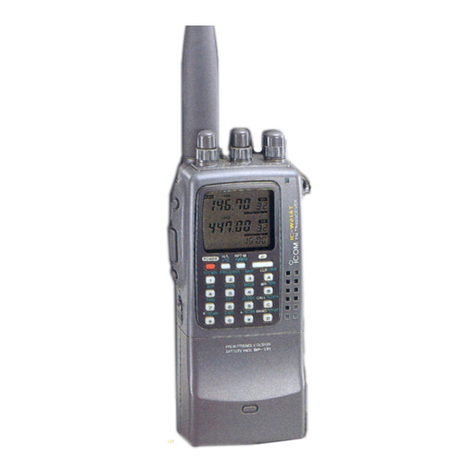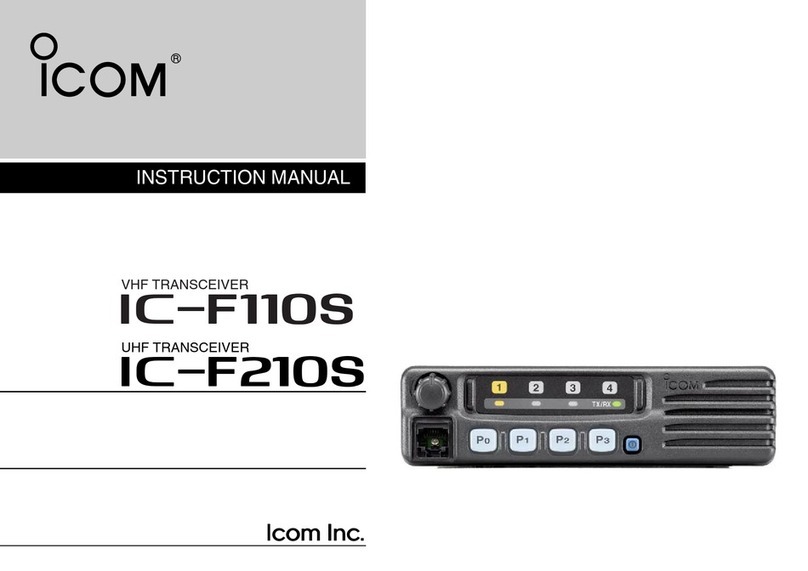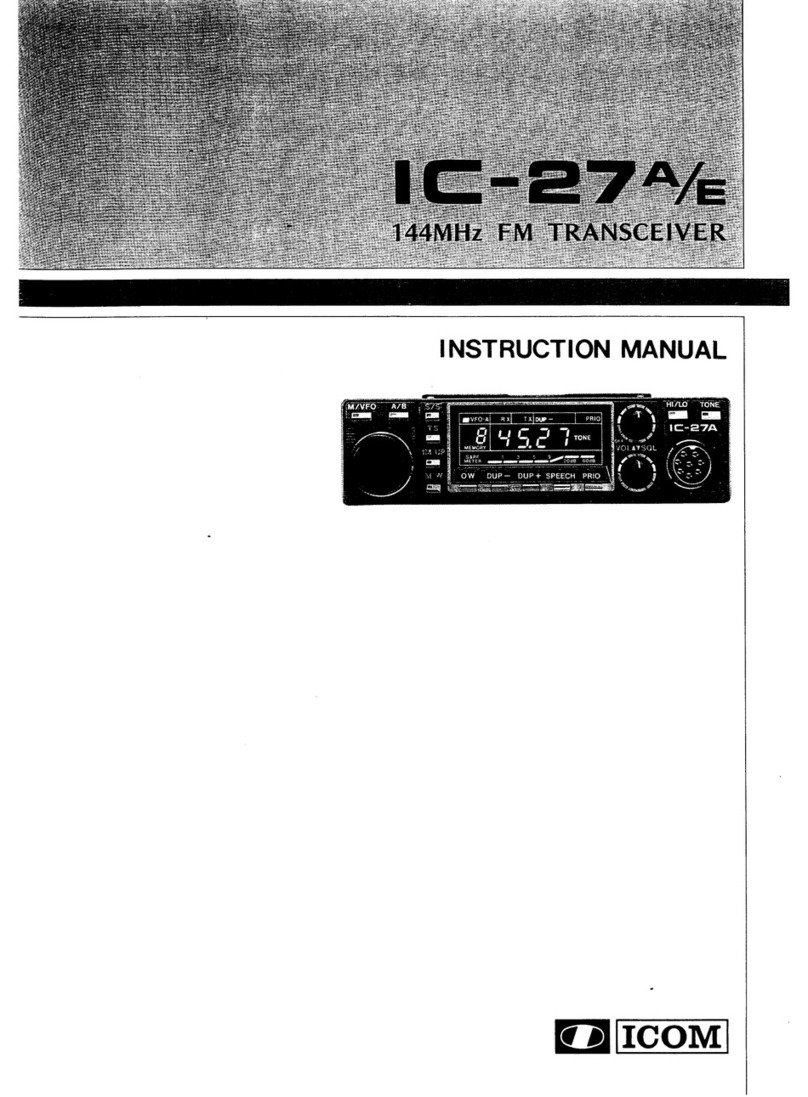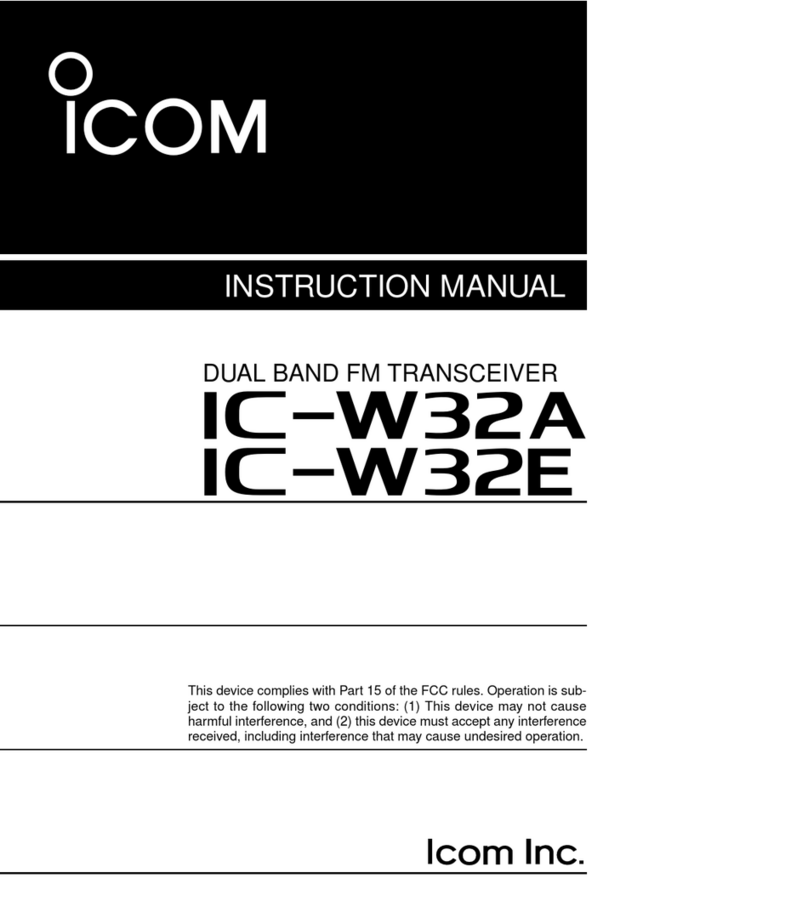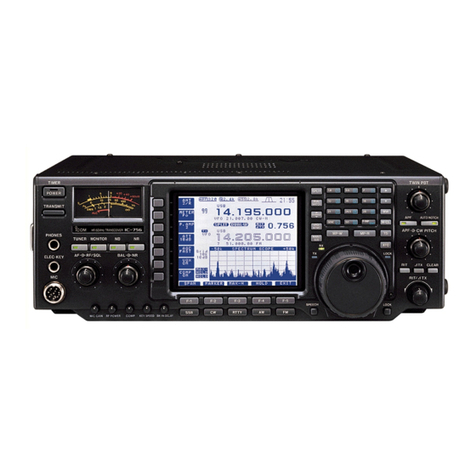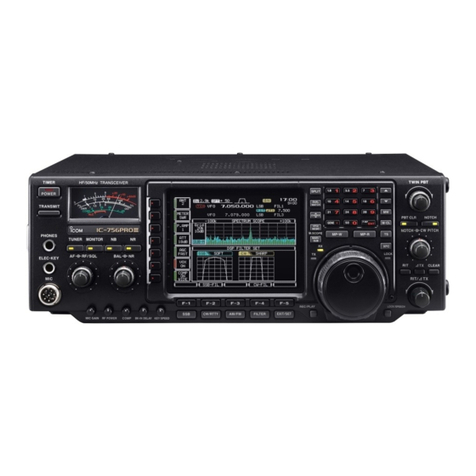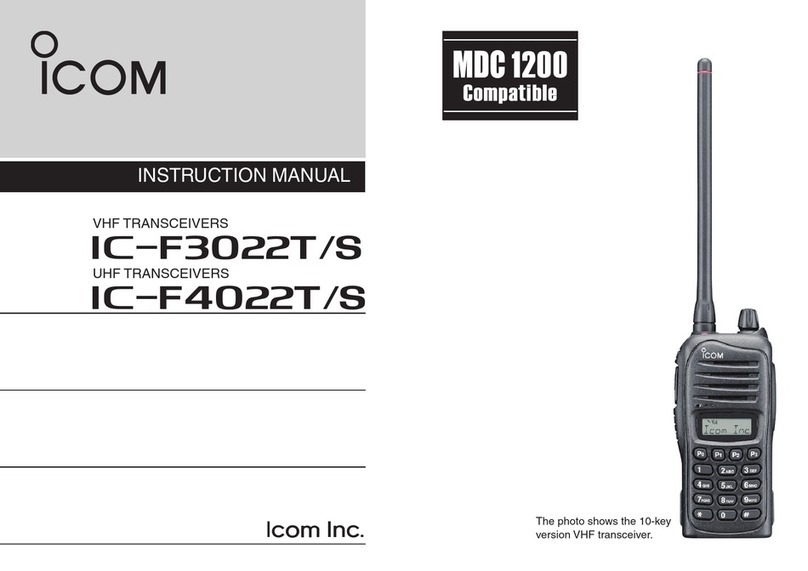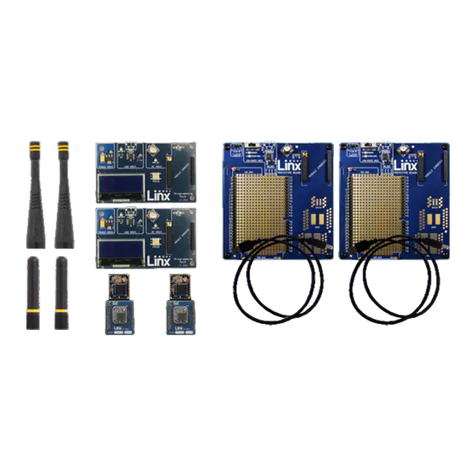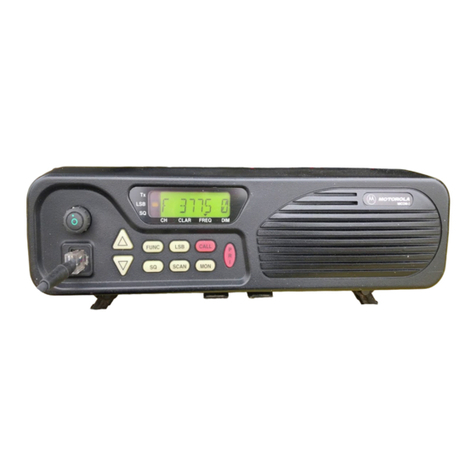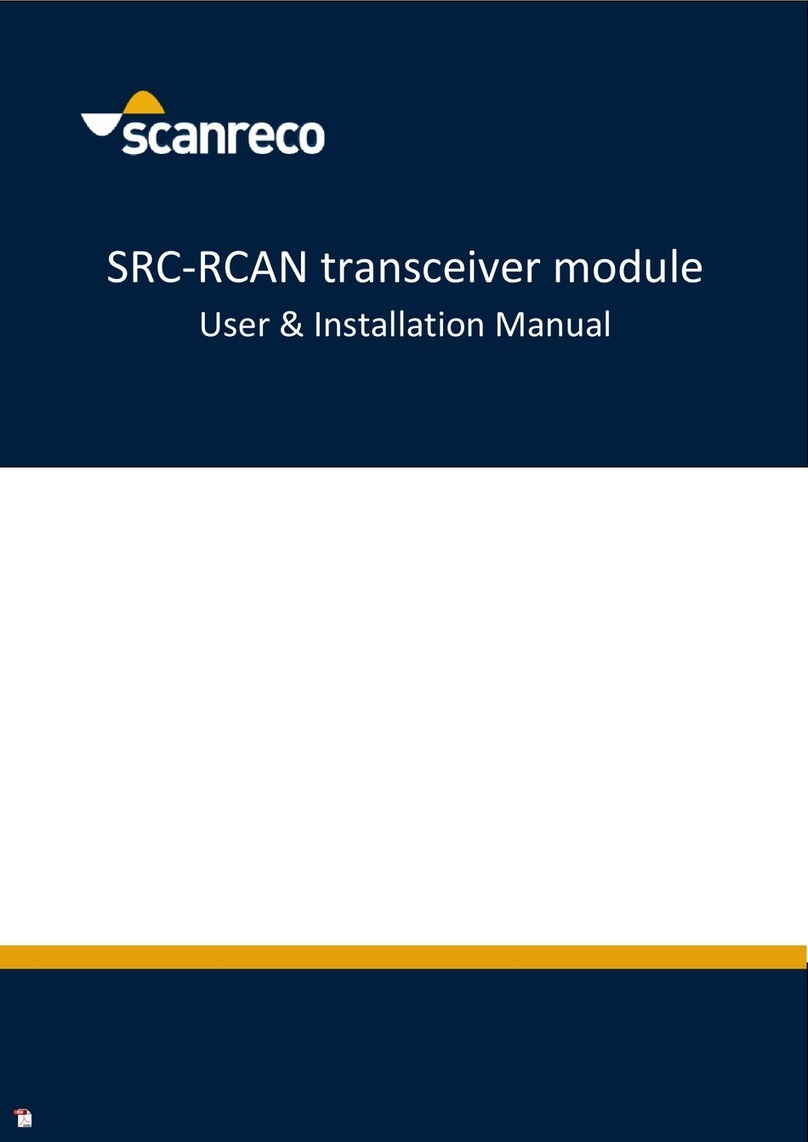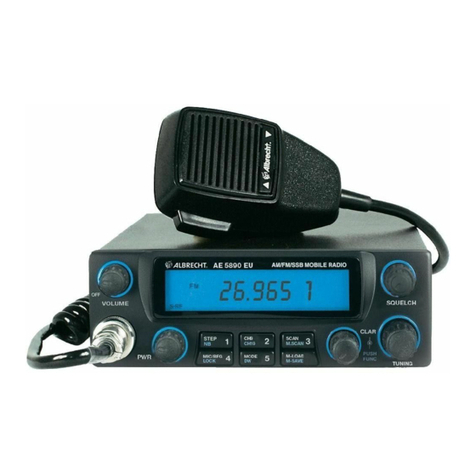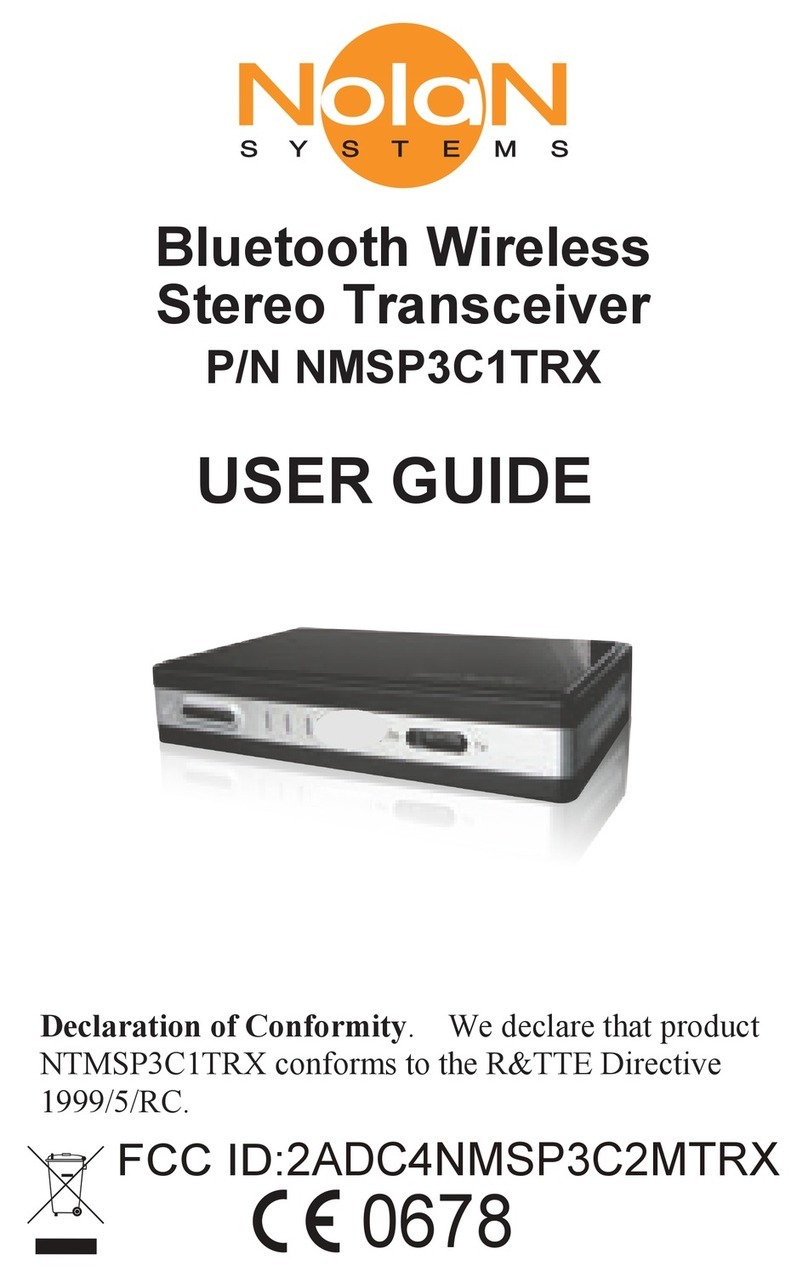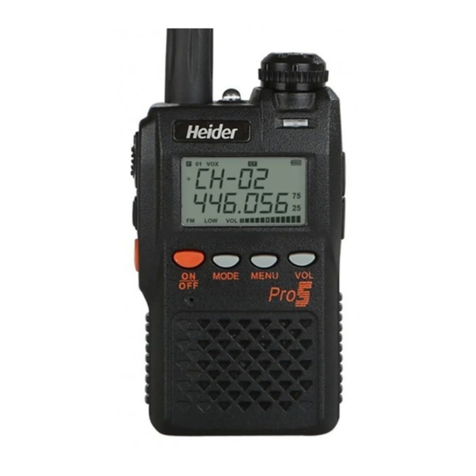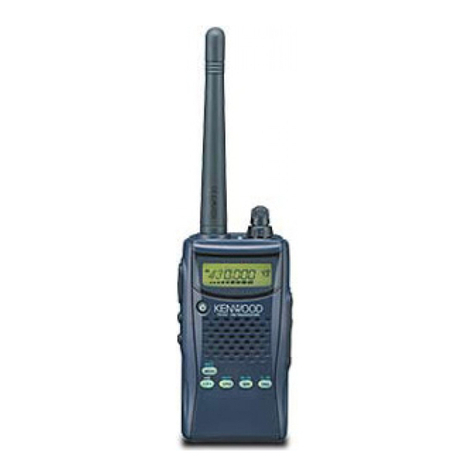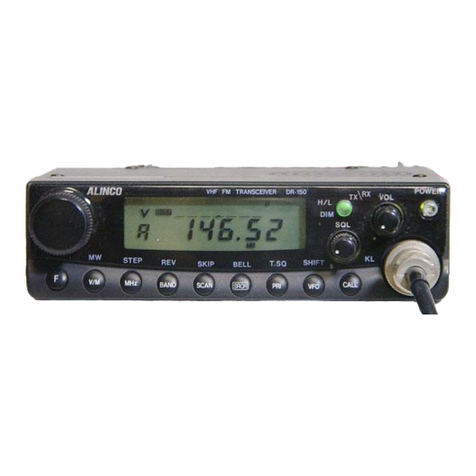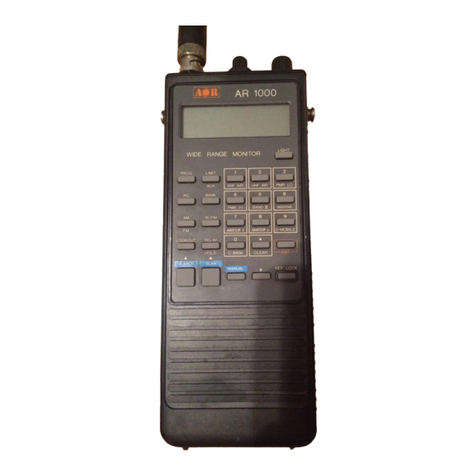Icom IC-746 User manual

INSTRUCTION MANUAL
VHF/HF ALL MODE TRANSCEIVER
i746
This device complies with Part 15 of the FCC rules. Operation is sub-
ject to the following two conditions: (1) This device may not cause
harmful interference, and (2) this device must accept any interference
received, including interference that may cause undesired operation.

The IC-746’s which display the “CE” symbol, comply
with the essential requirements of the 89/336/EEC di-
rective for Electromagnetic Compatibility. This compli-
ance is based on conformity with the ETSI specification
prETS300 684 (EMC product standard for Commer-
cially Available Amateur Radio Equipment).
ii
IMPORTANT
WORD DEFINITION
RWARNING Personal injury, fire hazard or electric
shock may occur.
CAUTION Equipment damage may occur.
NOTE If disregarded, inconvenience only. No risk
of personal injury, fire or electric shock.
READ THIS INSTRUCTION MANUAL CAREFULLY
before attempting to operate the transceiver. SAVE THIS INSTRUCTION MANUAL—This manual
contains important safety and operating instructions for
the IC-746.
PRECAUTIONS
RWARNING! HIGH VOLTAGE! NEVER attach an
antenna or internal antenna connector during trans-
mission.This may result in an electric shock or burn.
RNEVER apply AC to the [DC13.8V] socket on the
transceiver rear panel. This could cause a fire or ruin
the transceiver.
RNEVER apply more than 16 V DC, such as a 24 V
battery, to the [DC13.8V] socket on the transceiver rear
panel.This could cause a fire or ruin the transceiver.
RNEVER let metal, wire or other objects touch any in-
ternal part or connectors on the rear panel of the trans-
ceiver.This may result in an electric shock.
NEVER allow children to play with equipment contain-
ing a radio transmitter.
NEVER expose the transceiver to rain, snow or any liq-
uids.
AVOID using or placing the transceiver in areas with
temperatures below –10°C (+14°F) or above +60°C
(+140°F). Be aware that temperatures on a vehicle’s
dashboard can exceed 80°C (+176°F), resulting in per-
manent damage to the transceiver if left there for ex-
tended periods.
AVOID placing the transceiver in excessively dusty en-
vironments or in direct sunlight.
AVOID placing the transceiver against walls or putting
anything on top of the transceiver. This will obstruct
heat dissipation.
During mobile operation, DO NOT operate the trans-
ceiver without running the vehicle’s engine. When
transceiver power is ON and your vehicle’s engine is
OFF, the vehicle’s battery will soon become exhausted.
Make sure the transceiver power is OFF before start-
ing the vehicle.This will avoid possible damage to the
transceiver by ignition voltage spikes.
During maritime mobile operation, keep the transceiver
and microphone as far away as possible from the mag-
netic navigation compass to prevent erroneous indica-
tions.
BE CAREFUL! The heatsink will become hot when op-
erating the transceiver continuously for long periods.
BE CAREFUL! If a linear amplifier is connected, set
the transceiver’s RF output power to less than the lin-
ear amplifier’s maximum input level, otherwise, the lin-
ear amplifier will be damaged.
Use Icom microphones only (supplied or optional).
Other manufacturer’s microphones have different pin
assignments and connection to the IC-746 may dam-
age the transceiver.
EXPLICIT DEFINITIONS
The explicit definitions described below apply to this in-
struction manual.
BUILT-IN DSP
The IC-746’s DSP digitally transposes receive audio
components in all modes of operation to produce de-
sired AF frequency characteristics at the IF stage of
the transceiver. DSP provides the following functions:
➩Noise reduction—reduces various types of noise
and enhances receive signal components only.
➩
Automatic notch filter—automatically reduces single
beat interference and protects the receive voice signals.
➩Selectable APF—a total of 3 passband widths are
selectable (80/160/320 Hz), for super-narrow filter
APF functions in CW mode. The APF center fre-
quency is adjustable.
DSP

iii
TABLE OF CONTENTS
IMPORTANT . . . . . . . . . . . . . . . . . . . . . . . . . . . . . . ii
PRECAUTIONS . . . . . . . . . . . . . . . . . . . . . . . . . . . . ii
EXPLICIT DEFINITIONS . . . . . . . . . . . . . . . . . . . . . ii
BUILT-IN DSP . . . . . . . . . . . . . . . . . . . . . . . . . . . . . ii
TABLE OF CONTENTS . . . . . . . . . . . . . . . . . . . . . iii
1 PANEL DESCRIPTION . . . . . . . . . . . . . . . . . . 2–7
1-1 Front panel . . . . . . . . . . . . . . . . . . . . . . . . . . . 2
1-2 Rear panel . . . . . . . . . . . . . . . . . . . . . . . . . . . 6
1-3 Function display . . . . . . . . . . . . . . . . . . . . . . . 7
2 MENU SELECTION . . . . . . . . . . . . . . . . . . . . . 8–9
2-1 Menu set 1 flow chart . . . . . . . . . . . . . . . . . . . 8
2-2 Menu set 2 flow chart . . . . . . . . . . . . . . . . . . . 9
3 BASIC OPERATION . . . . . . . . . . . . . . . . . . 10–17
3-1 Before operating . . . . . . . . . . . . . . . . . . . . . . 10
3-2 Squelch and receive (RF) sensitivity . . . . . . 12
3-3 Selecting VFO/memory mode . . . . . . . . . . . 13
3-4 Toggling between VFO A/B and transferring
contents . . . . . . . . . . . . . . . . . . . . . . . . . . . . 13
3-5 Setting a band and frequency . . . . . . . . . . . 14
3-6 Selecting an operating mode . . . . . . . . . . . . 17
4 USING DIFFERENT OPERATING MODES . 18–36
4-1 Operating SSB . . . . . . . . . . . . . . . . . . . . . . . 18
4-2 Operating CW . . . . . . . . . . . . . . . . . . . . . . . . 20
4-3 Operating RTTY (FSK) . . . . . . . . . . . . . . . . . 28
4-4 Operating AM . . . . . . . . . . . . . . . . . . . . . . . . 30
4-5 Operating FM . . . . . . . . . . . . . . . . . . . . . . . . 32
4-6 Repeater operation . . . . . . . . . . . . . . . . . . . 34
4-7 Packet operation . . . . . . . . . . . . . . . . . . . . . . 36
5 FUNCTIONS FOR RECEIVE . . . . . . . . . . . . 37–42
5-1 Simple band scope . . . . . . . . . . . . . . . . . . . . 37
5-2 Preamp and attenuator . . . . . . . . . . . . . . . . 38
5-3 RIT function . . . . . . . . . . . . . . . . . . . . . . . . . 38
5-4 AGC function . . . . . . . . . . . . . . . . . . . . . . . . 39
5-5 1/4 function . . . . . . . . . . . . . . . . . . . . . . . . . . 39
5-6 NB function . . . . . . . . . . . . . . . . . . . . . . . . . . 39
5-7 Noise reduction . . . . . . . . . . . . . . . . . . . . . . 40
5-8 Auto notch (ANF) function . . . . . . . . . . . . . . 40
5-9 Dial lock function . . . . . . . . . . . . . . . . . . . . . 40
5-10 Twin PBT . . . . . . . . . . . . . . . . . . . . . . . . . . 41
5-11 Selecting IF filters . . . . . . . . . . . . . . . . . . . . 42
6 FUNCTIONS FORTRANSMIT . . . . . . . . . . . 43–48
6-1 VOX function . . . . . . . . . . . . . . . . . . . . . . . . . 43
6-2 Break-in function . . . . . . . . . . . . . . . . . . . . . 44
6-3 :TX function . . . . . . . . . . . . . . . . . . . . . . . . 45
6-4 Monitor function . . . . . . . . . . . . . . . . . . . . . . 45
6-5 Speech compressor . . . . . . . . . . . . . . . . . . . 46
6-6 Split frequency operation . . . . . . . . . . . . . . . 47
6-7 Quick split function . . . . . . . . . . . . . . . . . . . . 48
7 MEMORY CHANNELS . . . . . . . . . . . . . . . . 49–54
7-1 General . . . . . . . . . . . . . . . . . . . . . . . . . . . . . 49
7-2 Memory channel selection . . . . . . . . . . . . . . 49
7-3 Transferring a memory to VFO . . . . . . . . . . . 50
7-4 Clearing a memory . . . . . . . . . . . . . . . . . . . . 50
7-5 Selecting the call channel . . . . . . . . . . . . . . 51
7-6 Programming a memory . . . . . . . . . . . . . . . . 51
7-7 Programming the call channel . . . . . . . . . . . 52
7-8 Programming scan edges . . . . . . . . . . . . . . 52
7-9 Assigning memory names . . . . . . . . . . . . . . 53
7-10 Memo pads . . . . . . . . . . . . . . . . . . . . . . . . 54
8 SCAN OPERATION . . . . . . . . . . . . . . . . . . . 55–58
8-1 Scan types . . . . . . . . . . . . . . . . . . . . . . . . . . 55
8-2 Programmed scan and
fine programmed scan . . . . . . . . . . . . . . . . . 56
8-3 Memory scan . . . . . . . . . . . . . . . . . . . . . . . . 57
8-4 Select memory scan . . . . . . . . . . . . . . . . . . . 57
8-5 :F scan and fine :F scan . . . . . . . . . . . . . . 58
9 INTERNAL ANTENNATUNER . . . . . . . . . . . . . 59
9-1 Before operating . . . . . . . . . . . . . . . . . . . . . . 59
9-2 Tuner operation . . . . . . . . . . . . . . . . . . . . . . . 59
10 SET MODE . . . . . . . . . . . . . . . . . . . . . . . . . 60–64
10-1 Selecting set mode . . . . . . . . . . . . . . . . . . . 60
10-2 Set mode items . . . . . . . . . . . . . . . . . . . . . 60
11 ADJUSTMENTS . . . . . . . . . . . . . . . . . . . . . 65–66
11-1 Tuning dial brake . . . . . . . . . . . . . . . . . . . . 65
11-2 Frequency calibration . . . . . . . . . . . . . . . . . 65
11-3 Measuring SWR . . . . . . . . . . . . . . . . . . . . . 66
11-4 Adjusting the LCD . . . . . . . . . . . . . . . . . . . 66
12 SETUP AND CONNECTIONS . . . . . . . . . . 67–75
12-1 Front panel . . . . . . . . . . . . . . . . . . . . . . . . . 67
12-2 Rear panel . . . . . . . . . . . . . . . . . . . . . . . . . 68
12-3 Selecting a location . . . . . . . . . . . . . . . . . . 69
12-4 Power supply connections . . . . . . . . . . . . . 69
12-5 Grounding . . . . . . . . . . . . . . . . . . . . . . . . . 70
12-6 Antenna . . . . . . . . . . . . . . . . . . . . . . . . . . . 70
12-7 Data communications . . . . . . . . . . . . . . . . . 72
12-8 RTTY connections . . . . . . . . . . . . . . . . . . . 73
12-9 Remote jack . . . . . . . . . . . . . . . . . . . . . . . . 74
13 OPTIONAL INSTALLATIONS . . . . . . . . . . 76–80
13-1 Opening the transceiver’s case . . . . . . . . . 76
13-2 UT-102
VOICE SYNTHESIZER UNIT
. . . . . . . . . 77
13-3 CR-282
HIGH STABILITY CRYSTAL UNIT
. . . . . 77
13-4 Optional IF filters . . . . . . . . . . . . . . . . . . . . 78
13-5 Linear amplifier connections . . . . . . . . . . . 79
13-6 External antenna tuner connections . . . . . . 80
14 MAINTENANCE . . . . . . . . . . . . . . . . . . . . . 81–83
14-1 Fuse replacement . . . . . . . . . . . . . . . . . . . 81
14-2 Resetting the CPU . . . . . . . . . . . . . . . . . . . 81
14-3 Troubleshooting . . . . . . . . . . . . . . . . . . . . . 82
15 SPECIFICATIONS AND OPTIONS . . . . . . 84–85
15-1 Specifications . . . . . . . . . . . . . . . . . . . . . . . 84
15-2 Options . . . . . . . . . . . . . . . . . . . . . . . . . . . . 85

2
1PANEL DESCRIPTION
1-1 Front panel
qPOWER SWITCH [POWER]
➥Push momentarily to turn power ON. (p.11)
• Turn the optional DC power supply ON in advance.
➥Push and hold to turn power OFF.
wTRANSMIT SWITCH [TRANSMIT]
Toggles between transmit and receive.
• The [TX] indicator lights red while transmitting and the
[RX] indicator lights green when the squelch is open.
eHEADPHONE JACK [PHONES] (p. 67)
Accepts headphones.
• When headphones are connected, the internal speaker
or connected external speaker does not function.
rELECTRONIC KEYER JACK [ELEC-KEY] (p. 67)
Accepts a paddle to activate the internal electronic
keyer for CW operation.
• Selection between the internal electronic keyer, bug-key
and straight key operation can be made in keyer set
mode.
• A straight key jack is separately available on the rear
panel.
• Key polarity (dot and dash) can be reversed in keyer set
mode.
• 4-channel memory keyer is available for your conve-
nience.
tMICROPHONE CONNECTOR [MIC]
Accepts the supplied or optional microphone.
• See p.85 for appropriate microphones.
• See p.67 for microphone connector information.
yANTENNATUNER SWITCH [TUNER] (p. 59)
➥Turns the antenna tuner ON and OFF (bypass)
when pushed momentarily.
➥Starts to tune the antenna manually when
pushed for 2 sec.
• When the tuner cannot tune the antenna, the tuning
circuit is bypassed automatically after 20 sec.
uANTENNA SELECTOR SWITCH [ANT] (p. 71)
Toggles between the HF and 50 MHz antenna con-
nectors.
iNOISE REDUCTION LEVEL CONTROL [NR]
(p. 40)
Adjusts the noise reduction level when the noise re-
duction function is in use. Set for maximum read-
ability.
oAUDIO PEAK FILTER CONTROL [APF] (p. 20)
Varies the peak frequency of the audio peak filter to
pick out a CW signal from interference while the
APF function is ON.
!0 NOISE REDUCTION SWITCH [NR] (p. 40)
Toggles the noise reduction function ON and OFF.
Functions in SSB, CW and RTTY modes.
!1 AUDIO PEAK FILTER/AUTO NOTCH SWITCH
[APF/ANF]
➥Toggles between the audio peak (p.20) and auto
notch (p. 40) functions.
• The audio peak filter functions in CW mode only; the
auto notch functions in SSB, FM and AM modes only.
• The APF or ANF indicator appear in the display de-
pending on which function is selected.
➥When the APF indicator appears, push this
switch for 1 sec., one or more times to select 320
Hz, 160 Hz or 80 Hz bandwidths.
• Use the [APF] control to vary the peak frequency.
!2 AF CONTROL [AF] (inner control; p. 12)
Varies the audio output level from the speaker.
PHONES
TRANSMIT
POWER TUNER ANT
ELEC-KEY
MIC
NR APF/ANF
AF RF/SQL
NR APF
1
2
3
4
5
6
7
8
9
!1
!2
!3
!0
Å
Å
ı

3
1
PANEL DESCRIPTION
!3 RF GAIN/SQUELCH CONTROL [RF/SQL] (p. 12)
Adjusts the RF gain and squelch threshold level.
The squelch removes noise output from the speaker
(closed condition) when no signal is received.
•The squelch is particularly effective for FM. It is also
available for other modes.
•The control can be set as the RF gain control only
(squelch is fixed open) or squelch control (RF gain is
fixed at maximum) in set mode.
!4 MIC GAIN CONTROL [MIC GAIN]
Adjusts the microphone input gain.
!5 RF POWER CONTROL [RF PWR] (p. 84)
Continuously varies the RF output power from mini-
mum (2 W*) to maximum (100 W*).
*AM mode: 2–40 W, other modes: 5–100 W.
!6 CW PITCH CONTROL [CW PITCH] (p. 20)
Shifts the received CW audio pitch and monitored
CW audio pitch without changing the operating fre-
quency.
•The pitch can be changed from 300 to 900 Hz in approx.
3 Hz steps.
!7 ELECTRONIC CW KEYER SPEED CONTROL
[KEY SPEED] (p. 22)
Adjusts the internal electronic CW keyer’s speed.
•6 wpm to 60 wpm can be set.
!8 PREAMP/ATTENUATOR SWITCH [P.AMP/ATT]
(p. 38)
➥Push momentarily to toggle between preamp-1
and preamp-2.
➥Push for 1 sec. to toggle the attenuator function
ON and OFF.
!9 NOISE BLANKER SWITCH [NB] (p. 39)
Toggles the noise blanker ON and OFF. The noise
blanker reduces pulse-type noise such as that gen-
erated by automobile ignition systems.This function
cannot be used for FM, or non pulse-type noise.
@0 VOX/BREAK-IN SWITCH [VOX/BK-IN]
➥In SSB, AM and FM modes, push momentarily to
turn the VOX function ON; push for 1 sec. to turn
the VOX function OFF. (p.43)
➥In CW mode, push momentarily to select semi
break-in, full break-in or break-in OFF; push for 2
sec. to enter break-in set mode. (p. 44)
@1 MONITOR SWITCH [MONI] (p. 45)
➥Push to toggle the monitor function ON and OFF.
➥Push for 2 sec. to enter and exit monitor set
mode.
Adjustable
range
Maximum
RF gain Maximum
RF gain
sensitivity
Minimum
RF gain
sensitivity
•Setting squelch
•Setting RF gain
Squelch
threshold
Squelch
open S-meter squelch
operating
range
S-meter squelch
threshold
Noise squelch
operating range
MIC GAIN RF PWR CW PITCH P.AMP/ATTKEY SPEED NB VOX/BK-IN MONITOR
!4 !5 !6 !7 !8 !9 @0 @1
ı

4
1PANEL DESCRIPTION
@2 MULTI-FUNCTION SWITCHES (p. 8)
➥Push to select the functions indicated in the func-
tion display above these switches.
➥Push to input a character for memory keyer pro-
gramming or memory name.
@3 MENU SWITCH [MENU] (p. 8)
Push to change the set of functions assigned to the
multi-function switches.
•Toggles between menu set 1 and menu set 2.
@4 MODE SWITCHES (p. 17)
Select an operating mode.
•Push [SSB] to toggle between LSB and USB.
•Push [CW/RTTY] to toggle between CW and RTTY.
•Push [CW/RTTY] for 1 sec. to toggle between CW and
CW-R or RTTY and RTTY-R.
@5 FILTER SWITCH (pgs. 42, 78)
➥Push momentarily to toggle between normal and
narrow IF filters for the selected operating mode.
➥Push for 1 sec. to enter normal or narrow IF filter
set mode.
Ç Î
´
TS
1.8 13.5 273
10 414 518
144ENT
6
21 7
•
24 828 9
GENE
50 0A/B
SPLIT
F-INP
@7
@8
@9
#0
@6
Î
F1 F2 F3 F4 F5
MENU SSB
CW/RTTY
AM/FM FILTER
HF/VHF TRANSCEIVER
@2
Ç
@3 @4 @5
@6 KEYPAD (p. 14)
➥Push a key to select an operating band.
•[GENE] selects the general coverage band.
➥Push the same key 2 or 3 times to call up stacked
frequencies in the band.
•Icom’s band stacking register memorizes 3 frequen-
cies (and modes) in each band.
@7 FREQUENCY INPUT SWITCH [F-INP] (p. 17)
➥Toggles keypad input between frequency and
band.
•The LED lights green to indicate the switch is set for
frequency input.
@8 SPLIT SWITCH [SPLIT] (p. 47)
Push to toggle the split function ON and OFF.
•The LED lights green to indicate split operation (between
VFO A and VFO B is selected).
@9 A/B SWITCH [A/B] (p. 13)
➥Push to toggle between VFO A and VFO B.
➥Push for 1 sec. to equalize the contents of VFO
A and VFO B.
#0 QUICKTUNING STEP SWITCH [TS] (p. 15)
➥Turns the quick tuning step ON and OFF.
•While the quick tuning indicator is displayed, the fre-
quency can be changed in programmed kHz steps.
•1, 5, 9 and 10 kHz quick tuning steps are available.
➥While the quick tuning step is OFF, turns the 1 Hz
step ON and OFF when pushed for 2 sec.
•1 Hz indications appear in both readouts and the fre-
quency can be changed in 1 Hz steps.
➥While the quick tuning step is ON, enters the
quick tuning step mode when pushed for 2 sec.

5
1
PANEL DESCRIPTION
#1 TUNING DIAL
Changes the displayed frequency, selects set mode
items, etc.
#2 TRANSMIT FREQUENCY CHECK SWITCH [XFC]
(pgs.34, 38, 45, 47)
Monitors the transmit frequency when pushed and
held when the split frequency function is ON.
•While pushing this switch, the transmit frequency can be
changed with the tuning dial, keypad or the memo pad.
•When the split lock function is turned ON, pushing [XFC]
cancels the dial lock function.
#3 MEMO PAD WRITE SWITCH [MP-W] (p. 54)
Programs the selected readout frequency and oper-
ating mode into a memo pad.
•The 5 most recent entries remain in memo pads.
•The transmit frequency is programmed when pushed to-
gether with [XFC].
•The memo pad capacity can be expanded from 5 to 10
in set mode for your convenience.
#4 TRANSMIT INDICATOR [TX]
Lights red while transmitting.
#5 MEMO PAD READ SWITCH [MP-R] (p. 54)
Each push calls up a frequency and operating mode
in a memo pad. The (or 10) most recently pro-
grammed frequencies and operating modes can be
recalled, starting from the most recent.
•The memo pad capacity can be expanded from 5 to 10
in set mode for your convenience.
#6 RECEIVE INDICATOR [RX]
Lights green while receiving a signal or when the
squelch is open.
#7 LOCK INDICATOR [LOCK] (p. 40)
Lights when the dial lock function is activated.
#8 SPEECH SWITCH [SPEECH] (p. 77)
Announces the selected readout frequency when an
optional UT-102 is installed.
#9 LOCK SWITCH [LOCK] (p. 40)
Turns the dial lock function ON and OFF.
$0 RIT SWITCH [RIT] (p. 38)
➥Turns the RIT function ON and OFF when
pushed.
•Use the [RIT/:TX] control to vary the RIT frequency.
➥Adds the RIT shift frequency to the operating fre-
quency when pushed for 2 sec.
$1 :TX SWITCH [:TX] (p. 45)
➥Turns the :TX function ON and OFF when
pushed.
•Use the [RIT/:TX] control to vary the :TX fre-
quency.
➥Adds the :TX shift frequency to the operating
frequency when pushed for 2 sec.
$2 CLEAR SWITCH [CLEAR] (pgs. 38, 45)
Clears the RIT/:TX shift frequency when pushed
for 2 sec.
$3 RIT/:TX CONTROL [RIT/:TX] (pgs. 38, 45)
Shifts the receive and/or transmit frequency without
changing the transmit and/or receive frequency
while the RIT and/or :TX functions are ON.
•Rotate the control clockwise to increase the frequency,
or rotate the control counterclockwise to decrease the
frequency.
•The shift frequency range is ±9.999 kHz in 1 Hz steps
(or ±9.99 kHz in 10 Hz steps).
$4 BRAKE ADJUSTMENT SCREW (p. 65)
Adjusts the tension of the tuning dial.
•Rotate clockwise to increase the tension; counterclock-
wise to decrease the tension.
LOCK
XFC
RIT/ TX
SPEECH LOCK
TX RX
MP-W MP-R
RIT TX CLEAR
´#1 #2 #3 #4 #5 #6 #7
#8
#9
$0 $1 $2
$3
$4

6
1PANEL DESCRIPTION
$5 PASSBANDTUNING CONTROLS [TWIN PBT]
(p. 41)
Adjust the receiver’s “passband width”of the 455
kHz and 9 kHz IF filters for the inner and outer con-
trols, respectively.
•Passband width and center frequency are displayed in
the function display.
•Set to the center positions when not in use.
•Variable range depends on the filter selection.±1.29 kHz
in 15 Hz steps and ±258 Hz in 3 Hz steps are available.
$6 VFO/MEMORY SWITCH [V/M]
➥Toggles the selected readout operating mode be-
tween VFO mode and memory mode when
pushed.
➥Transfers the memory contents to VFO when
pushed for 2 sec.
$7 CALL CHANNEL SWITCH [CALL] (p. 51)
Brings up the call channel.
•When the call channel is displayed, push this switch to
exit call channel mode.
$8 MEMORY WRITE SWITCH [MW] (p. 51)
Stores the selected readout frequency and operat-
ing mode into the displayed memory channel when
pushed for 2 sec.
•This function is available in both VFO and memory
modes.
$9 MEMORY CLEAR SWITCH [M-CL] (p. 50)
Clears the selected readout memory channel con-
tents when pushed for 2 sec. in memory mode.
•This switch does not function in VFO mode.
%0 MEMORY CHANNEL CONTROL [M-CH] (p.49)
Selects a memory channel.
•Rotate clockwise to increase the memory channel; ro-
tate counterclockwise to decrease the memory channel.
Ï
M-CH
V/M CALL
M VFO
TWIN PBT
MW M-CL
Ï
$5
$6 $7
$8 $9
%0
wq
[ANT1][ANT2]
[ANT144MHz]
[REMOTE]
[SP]
[KEY JACK] [ACC1/2] [SEND]
[ALC]
1-2 Rear panel
qCALIBRATION POT [CAL]
This is used for frequency calibration (p. 65).
•The transceiver has been adjusted and calibrated thor-
oughly at the factory. Under normal circumstances, the
frequency does not need to be recalibrated.
wCOMPRESSION LEVEL CONTROL [COMP GAIN]
(p. 46)
Adjusts the speech compression level in SSB.
☞NOTE: Refer to “12-2 Rear panel”(p.68) for details
concerning other rear panel connectors, etc.

7
1
PANEL DESCRIPTION
qANTENNATUNER INDICATORS (pgs. 59, 79)
➥“TUNE”appears when the antenna tuner is ON;
“TUNE”appears and flashes during manual tun-
ing.
➥“EXT”appears when the optional AH-4 external
HF antenna tuner is connected to [ANT1].
wANTENNA INDICATORS (p. 71)
Indicate which antenna connector is in use for
HF/50 MHz.
eMODE INDICATORS (p. 7)
Indicate the selected operating mode.
rNARROW FILTER INDICATOR (p. 42)
Appears when the narrow IF filter is selected.
t1⁄4TUNING DIAL SPEED INDICATOR (p. 39)
Appears when the tuning dial is set so that one rev-
olution is equal to 1⁄4 of the normal revolution.
yFREQUENCY READOUT
Shows the operating frequency.
uMULTI-FUNCTION METER INDICATION
Displays S-meter reading during receive;“P0,”“ALC”
and “SWR”meters can be selected for transmit.
iRIT/:TX INDICATORS (pgs. 38, 45)
Appear during RIT or :TX operation and indicate
the frequency offset.
oVFO/CALL/MEMORY INDICATORS
Indicate whether VFO A, VFO B, the call channel or
memory mode is selected.
!0 BLANK MEMORY INDICATOR (p. 49)
Appears when the selected memory channel is
blank.
!1 SELECT MEMORY INDICATOR (p. 57)
Appears when the selected memory channel is a
“select”memory channel.
BLANK
14
MWAPF
CH
MEMO
VFOB
VFOA SEL
NR
ANFTSQLXFC
TUNE ANT RTTY RAMWFM
NBMONICOMP DUPSPLIT
RIT TX
OFFAGCATTAMP
P.BKVOX
SWR
ALC
Po
S1
20 50
3
3211.5
579 20 40 60
IN N
100%
EXT NAR
CALL
21
F12FS
LSBUSBCW
M1
AGCDUPCMPTCNSCP
BLANK
MWAPF
CH
MEMO
VFOB
VFOA SEL
NR
ANFTSQLXFCNBMONICOMP DUPSPLIT
RIT TX
OFFAGCATTAMP
P.BKVOX IN N
CALL
F12FS
123
4
5
6
7
89
!1
!0
!2
!3 !4 !5 !6
!7
!2 MEMORY CHANNEL INDICATOR (p. 49)
Shows the selected memory channel.
!3 TRANSMIT FUNCTION INDICATORS
Indicate functions selected for transmit.
!4 RECEIVE FUNCTION INDICATORS
Indicate functions selected for receive.
!5 SPLIT FUNCTION INDICATOR
Appears during split operation.
!6 DSP FUNCTION INDICATORS
Appear when DSP functions are selected.
!7 MULTI-FUNCTION SWITCH INDICATORS (p. 8)
Indicate the functions assigned to the multi-function
switches (F1–F5).
1-3 Function display

8
2MENU SELECTION
M1M2M3M4 -1
BLANK
CH
ANT USB
AGCAMP
P.
SWR
ALC
Po
S1
20 50
3
3211.5
579 20 40 60
100%
1
1
S
M1
AGCDUPCMPTCNSCP
F1 F2 F3 F4 F5
TCN
LH
0
SSBTXTone
SCP STEP
0.5k
F1 F5
F1 F2 F3 F4 F5
M1
AGCDUP1/4KE SCP
F2 F3 F4 F5
SNDEDT001SET
KE
F1 F2 F3 F4 F5
001
SND
50%
SideToneLevel
SET
F1 F2
Normal
NumberStyle
001
F1 F2
F1 F2 F3 F4 F5
EDT
M1 DELSPC
CQTESTCQTEST
F5
F4
F3
F1 F2 F3 F4 F5
M1
AGCDUP1/4RT SCP
2125
RTT Mark
RT
F1 F2
F1 F2 F3 F4 F5
M1
AGCDUPTONTSQSCP
F1 F2 F3 F5
M1
AGCDUPCMPSCP
VFOA
SSB MODE
BAND SCOPE MENU
RTTY MODE
AM MODE
FM MODE
CW MODE
To band scope
menu
EDIT MENU
CONTEST NUMBER MENU
KEYER SET MODE
MEMORY KEYER MENU
SEND MENU
(p. 24)
(p. 23)
(p. 27)
(p. 26)
(p. 25)
(
p. 37
)
(p. 29)
(p. 19)
RTTY MENU
TONE CONTROL MENU
To band scope
menu
To band scope
menu
To band scope
menu
To band scope
menu
2-1
Menu set 1 flow chart
Pushing [MENU] toggles between menu set 1 (M1)
and menu set 2 (M2) in the function display. Depending on the mode and menu item selected, the
action of the multi-function keys ([F1] to [F5]) changes.

9
2
MENU SELECTION
F5
F2
F3
F5
BLANK
CH
ANT USB
AGCAMP
P.
SWR
ALC
Po
S1
20 50
3
3211.5
579 20 40 60
100%
1
1S
M2
SCNMEMLCDSET
F1 F2 F3 F5
SCN 10k
+
-
∂F
PRO∂FFINSPNSET
F1 F2 F3 F4 F5
SCN 10k
+
-
∂F
MEM∂FSELSPNSET
F-1 F-2 F-3 F-4 F-5
SCANSpeed
HIGH
SET
F1 F2
F1 F5
MEM 14.1000USB
EDT()SEL
EDT
ABC DELSPC
F1 F2 F3 F4 F5
LCDContrast
50%
LCD
F1 F2
VFO MODE
MEMORY MODE
50%
BeepLevel
SET
F1 F2
VFOA
(p. 55)
SET MODE
SCAN SET MENU
LCD MENU
MEMORY NAME MENU
NAME EDIT MENU
(p. 53)
(p. 66)
(p. 53)
(p. 60)
SCAN MENU (pgs. 56–58)
2-2
Menu set 2 flow chart
MENU MODE F1 F2 F3 F4 F5
SSB qAGC wDUP eCMP rTCN tSCP
CW AGC DUP y1/4 uKEY SCP
M1 RTTY AGC DUP 1/4 iRTY SCP
AM AGC DUP CMP SCP
FM AGC DUP oTON !0 TSQ SCP
M2 ALL !1 SCN !2 MEM !3 LCD !4 SET
qAGC (auto gain control) : p. 39
wDUP (duplex) : p. 35
eCMP (speech compressor) : p. 46
rTCN (tone control) : p. 20
tSCP (band scope) : p. 37
y1/4 (dial rate) : p. 39
uKEY (CW key) : p. 24
iRTY (RTTY) : p. 30
oTON (repeater tone) : p. 35
!0 TSQ (tone squelch) : p. 33
!1 SCN (scan) : p. 55
!2 MEM (memory names) : p. 53
!3 LCD (function display) : p. 66
!4 SET (set mode) : p. 60

10
3BASIC OPERATION
3-1
Before operating
ÅBEFORE APPLYING POWER
Before applying power for the first time, check the fol-
lowing points:
➥Is the connected external power supply capable of
delivering more than 20 A?
➥Are the antenna(s) connected properly?
•[ANT1/2]: HF/50 MHz antenna
•[144MHz]: 144 MHz antenna
➥Is the transceiver properly grounded? (p. 70)
➥Is external equipment, such as a linear amplifier
connected properly? (p.79)
➥Make sure the front panel switches and controls are
set as illustrated below.
F1 F2 F3 F4 F5
PHONES
TRANSMIT
POWER TUNER ANT
ELEC-KEY
MIC
M-CH
V/M CALL
M VFO
LOCK
XFC
TWIN PBT
NR APF/ANF
AF RF/SQL
NR APF
RIT/ TX
MIC GAIN RF PWR CW PITCH P.AMP/ATTKEY SPEED NB VOX/BK-IN MONITOR SPEECH LOCK
TX RX
MENU SSB
CW/RTTY
AM/FM FILTER
MW
MP-W
HF/VHF TRANSCEIVER
MP-R TS
M-CL
RIT TX CLEAR
1.8 13.5 273
10 414 518
144ENT
6
21 7
24 828 9
GENE
50 0A/B
SPLIT
F-INP
Rearpanel
12
3
4
5
6789
!0
qRotate [NR] max. counterclockwise.
wSet [APF] to the center position.
eSet [TWIN PBT] to the center position.
rRotate [AF] max. counterclockwise.
tSet [RF/SQL] to the center position.
yRotate [MIC GAIN] max. counterclockwise.
uRotate [RF PWR] max. counterclockwise.
iSet [CW PITCH] to the center position.
oRotate [KEY SPEED] max. counterclockwise.
!0 Rotate [COMP GAIN] max. counterclockwise.

11
3
BASIC OPERATION
ıAPPLYING POWER
ÇADJUSTING VOLUME Rotate [AF] to obtain a comfortable listening level.
•Clockwise rotation increases audio output; counterclock-
wise decreases audio output.
When applying power to the transceiver for the first
time, it’s a good idea to reset the CPU (see p. 81 for
details) as follows:
While pushing [F-INP] + [M-CL], push [POWER] to turn
power ON.
•After the CPU has been reset, turn power ON by pushing
[POWER] only.
•Push [POWER] for 1 sec.to turn power OFF.
[F-INP] [M-CL]
[POWER]
BLANK
CH
ANT USB
AGCAMP
P.
SWR
ALC
Po
S1
20 50
3
3211.5
579 20 40 60
100%
1
1S
M1
AGCDUPCMPTCNSCP
VFOA
☞NOTE: When first applying power or when operat-
ing in cold environments, the display may flicker or
appear faint.This is normal and will disappear once
the transceiver has warmed up.
[AF]
Increasing audio
output

12
3BASIC OPERATION
3-2
Squelch and receive (RF)
sensitivity
[RF/SQL]
RF gain
range
RF gain
operating
range
Squelch
open
Squelch
threshold
Squelch
open
S-meter
squelch
range
S-meter squelch
operating
range
S-meter squelch
threshold
Noise squelch
range
Noise squelch
operating range
RF gain
max.
sensitivity
Max.
RF gain
sensitivity
Minimum
RF gain
sensitivity
Max. RF gain
Adjusts the RF gain and squelch threshold level. The
squelch removes noise output from the speaker
(closed condition) when no signal is received.
•The squelch is particularly effective for FM. It is also avail-
able for other modes.
•The control can be set as the RF gain control only (squelch
is fixed open) or squelch control (RF gain is fixed at maxi-
mum) in set mode (p. 61). See below left.
•The 11 to 12 o’clock position is recommended for any set-
ting of the [RF/SQL] control.
When setting as RF gain/squelch control
When setting as RF gain (squelch is fixed open) Adjusting RF gain (receive sensitivity)
Normally, [RF/SQL] is set to the 11 o’clock position.
Rotate [RF/SQL] to the 11 o’clock position for maxi-
mum sensitivity.
•Rotating counterclockwise from the maximum position re-
duces sensitivity.
•The S-meter indicates receive sensitivity.
When setting as squelch (RF gain is fixed at max.) Adjusting squelch (removing non-signal noise)
Rotate [RF/SQL] clockwise, when receiving no signal,
until the noise just disappears.
•[RX] indicator light goes out.
•Rotating [RF/SQL] past the threshold point invokes the S-
meter squelch—this allows you to set a minimum signal
level needed to open the squelch.
SET MODE
RF + SQL
(default)
SQL
RF
OPERATION
Can be used in all modes.
Functions as noise squelch or S-
meter squelch in FM; S-meter
squelch only in other modes.
➥Operates as a squelch control.
•RF gain is fixed at max. sensitivity.
➥Operates as an RF gain control.
•Squelch is fixed open.

13
3
BASIC OPERATION
3-3
SelectingVFO/memory mode
[V/M]
■VFO DISPLAY (default)
BLANK
CH
ANT USB
AGCAMP
P.
SWR
ALC
Po
S1
20 50
3
3211.5
579 20 40 60
100%
1
1S
M1
AGCDUPCMPTCNSCP
VFOA
■MEMORY DISPLAY (default)
CH
AGCAMP
P.
SWR
ALC
Po
S1
20 50
3
3211.5
579 20 40 60
100%
1S
M1
AGCDUPCMPTCNSCP
MEMO
BLANK
[A/B]
Rotating the tuning dial selects frequencies in VFO
mode or pre-programmed memories in memory mode.
Push [V/M] to toggle between memory and VFO
modes.
•Pushing [V/M] for 2 sec. transfers the contents of the se-
lected memory channel to VFO mode (p. 50).
3-4
Toggling between VFO A/B
and transferring contents In VFO mode,VFO A or VFO B can be selected. In ad-
dition, contents can be transferred between them.
➥Push [A/B] to toggle between VFO A and VFO B.
➥Push [A/B] for 1 sec. to transfer the contents of the
displayed VFO to the undisplayed VFO.
BLANK
CH
ANT USB
AGCAMP
P.
SWR
ALC
Po
S1
20 50
3
3211.5
579 20 40 60
100%
1
1S
M1
AGCDUPCMPTCNSCP
VFOA
■WHEN OPERATING IN VFO A
BLANK
CH
ANT USB
AGCAMP
P.
SWR
ALC
Po
S1
20 50
3
3211.5
579 20 40 60
100%
1
1S
M1
AGCDUPCMPTCNSCP
VFOB
■WHEN OPERATING IN VFO B

14
3BASIC OPERATION
3-5 Setting a band and frequency
ÅSETTING AN OPERATING BAND
The transceiver has a triple band stacking register.This
means that the last 3 operating frequencies and
modes used on a particular band are automatically
memorized.
See the table below for a list of the bands available and
the default settings for each register.
Bandkeys
1.8 13.5 273
10 414 518
144ENT
6
21 7
•
24 828 9
GENE
50 0
■USINGTHE BAND STACKING REGISTERS
[EXAMPLE]: 21 MHz band
➀Push [21¶], then select a frequency and an operat-
ing mode.
•Frequency and operating mode are memorized in the
first band stacking register.
➁Push [21¶] again, then select another frequency
and operating mode.
•This frequency and operating mode are memorized in
the second band stacking register.
➂Push [21¶] again, then select another frequency
and operating mode.
•This frequency and operating mode are memorized in
the third band stacking register.
•When a fourth frequency and operating mode are se-
lected on a band, the first register is overwritten.
BAND REGISTER 1 REGISTER 2 REGISTER 3
1.9 MHz 1.900000 CW 1.910000 CW 1.915000 CW
3.5 MHz 3.550000 LSB 3.560000 CW 3.580000 LSB
7 MHz 7.050000 LSB 7.060000 CW 7.020000 CW
10 MHz 10.120000 CW 10.130000 CW 10.140000 CW
14 MHz 14.100000 USB 14.200000 USB 14.050000 CW
18 MHz 18.100000 USB 18.130000 USB 18.150000 USB
21 MHz 21.200000 USB 21.300000 USB 21.050000 CW
24 MHz 24.950000 USB 24.980000 USB 24.900000 CW
28 MHz 28.500000 USB 29.500000 USB 28.100000 CW
50 MHz 50.100000 USB 50.200000 USB 51.100000 FM
145 MHz 145.000000 USB 145.100000 FM 145.200000 FM
General 15.000000 USB 15.100000 USB 15.200000 USB

15
3
BASIC OPERATION
ıSETTING A FREQUENCYWITHTHE
TUNING DIAL Frequencies can be selected with the tuning dial or di-
rectly with the keypad (p. 17). When using the tuning
dial, the frequency changes according to the set tun-
ing step. Tuning step defaults differ depending on op-
erating mode as shown below.
SSB/CW/RTTY: 10 Hz
AM: 1 kHz
FM: 10 kHz
➥Rotate the tuning dial clockwise to increase the fre-
quency; counterclockwise to decrease the fre-
quency.
Tuning dial
■BAND EDGEWARNING BEEPS When selecting a frequency that lies outside of a
band’s specified frequency range, a warning beep
sounds.
This function can be turned off in set mode, if desired
(p. 61).
Tuning steps automatically change according to the
rate at which the tuning dial is rotated.
When rotated slowly, one complete revolution of the
tuning dial changes the frequency 5 kHz (10 Hz tuning
steps); when rotated quickly, one complete revolution
of the tuning dial changes the frequency 25 kHz (50
Hz tuning steps).
Rotate the tuning dial to change the frequency in 10
Hz steps or use the microphone [UP]/[DN] keys to
change the frequency in 50 Hz steps. The diagram
below illustrates how to change the tuning steps.
■AUTOTUNING STEPS
■CHANGINGTUNING STEPS
TS function OFF
Fine tuning
(
1
Hz)
TS function OFF
(1 kHz)*
*FM mode only 10 kHz
TS set mode
(0.1, 1, 5, 9, 10,
12.5, 20, 25 kHz)
SSB/CW/RTTY mode only All modes
[TS]
momentarily
[TS]
momentarily
[TS]
2 sec.
[TS]
2 sec. [TS]
2 sec.
•Using the [TS] switch

16
3BASIC OPERATION
■TOGGLINGTHETS FUNCTION ON AND OFF The tuning step function can be turned ON and OFF.
When the TS function is ON (default), rotating the tun-
ing dial changes the frequency in the set tuning steps.
➀Push [TS] to turn the tuning step function ON, if nec-
essary.
•The TS indicator, “Z”appears.
➁Rotate the tuning dial to change the frequency ac-
cording to the set tuning step.
➂Push [TS] again to turn the tuning step function
OFF.
•The TS indicator, “Z”disappears.
■TUNING STEP PROGRAM MODE When the tuning step function is ON, tuning step pro-
gram mode can be selected. This mode is used to
change the set tuning steps.
➀While the tuning step function is ON, (“Z”appears),
push [TS] for 2 sec. to enter tuning step program
mode.
➁Rotate the tuning dial to select the desired tuning
step.
•0.1, 1, 5, 9, 10, 12.5, 20 and 25 kHz can be selected.
•Tuning steps can be set individually for each operating
mode.
➂Push [TS] again to exit tuning step program mode.
■1 Hz TUNING For critical tuning, a 1 Hz tuning step can be selected.
➀While the tuning step function is OFF, (“Z”does not
appear), push [TS] for 2 sec.
•The 1 Hz indicator appears.
➁Rotate the tuning dial to change the frequency in 1
Hz steps.
•When changing the frequency via the microphone, the
frequency changes in 50 Hz steps, regardless of whether
the 1 Hz tuning step is selected or not.
➂Push [TS] for 2 sec. again (while the tuning step
function is OFF) to turn the 1 Hz tuning step OFF.
Tuning dial [TS]
BLANK
CH
VFOA
ANT
AGCAMP
P.
SWR
ALC
Po
S1
20 50
3
3211.5
579 20 40 60
100%
1
1S
M1
F
USB
TS indicator
AGCDUPCMPTCNSCP
BLANK
CH
VFOA
ANT
AGCAMP
P.
SWR
ALC
Po
S1
20 50
3
3211.5
579 20 40 60
100%
1
1S
0.1kHz
SSB
TS
F
USB
TS indicator
BLANK
CH
ANT USB
AGCAMP
P.
SWR
ALC
Po
S1
20 50
3
3211.5
579 20 40 60
100%
1
1S
M1
AGCDUPCMPTCNSCP
VFOA
The tuning step defaults are:
SSB/CW/RTTY: 10 Hz
AM: 1 kHz
FM: 10 kHz

17
3
BASIC OPERATION
ÇSETTING A FREQUENCYVIATHE KEYPAD The keypad can be used to enter frequencies directly.
➀Push [F-INP] to activate keypad input.
➁Enter the desired frequency using the correspond-
ing digit keys on the keypad.
•The displayed frequency is cleared and input starts at the
far right of the frequency display.
•Input “•” (decimal point) between the MHz units and kHz
units.
•Push [F-INP] to cancel input and return to the previous
frequency.
➂When the desired frequency is input, push [144ENT]
to set the displayed frequency.
Keypad [F-INP]
Lights when keypad input is activated
3-6
Selecting an operating mode
Each push of a mode key changes the operating fre-
quency. In addition, in CW and RTTY modes, pushing
[CW/RTTY] for 2 sec. toggles between reverse and
normal modes.
SSB mode
Above 10 MHz, USB is automatically selected; below
10 MHz, LSB is automatically selected.
CW mode
Use CW-R mode when nearby BFO frequencies are
causing interference.
RTTY mode
When an all mode TNC is connected, RTTY(FSK) op-
eration is possible.
[SSB]
[CW/RTTY]
[AM/FM]
[EXAMPLES]:
Setting 7.000000 MHz
Push [F-INP] + [21¶] + [144ENT]
Setting 14.025000 MHz
Push [F-INP] + [1.8¬]+[10¢] + [GENE(•)] + [50Ø]+
[3.5™]+[14∞] + [144ENT]
Setting 145.500000 MHz
Push [F-INP] + [1.8¬)] + [10¢] + [14∞] + [GENE(•)] +
[14∞] + [144ENT]
Setting 145.500000 MHz from 145.360000 MHz
Push [F-INP] + [GENE] + [7£)] + [18§] + [144ENT]
MODE KEY
[SSB]
[CW/RTTY]
[AM/FM]
MOMENTARY PUSH
Toggles between LSB and USB
Toggles between CW and RTTY
Toggles between AM and FM
PUSH FOR 2 SEC.
No function
Toggles between CW and CW-R or RTTY and RTTY-R
No function

18
4USING DIFFERENT OPERATING MODES
4-1 Operating SSB
ÅRECEIVING
➀Push a band key to select the desired band.
➁Push [SSB] to select LSB or USB.
•Below 10 MHz LSB is automatically selected; above 10
MHz USB is automatically selected.
➂Rotate [AF] to set audio to a comfortable listening
level.
➃Rotate the tuning dial to tune a desired signal.
•S-meter indicates received signal strength.
[BAND]
[DIAL][SSB][AF]
✔Convenient functions for receive
qPreamp and attenuator (p. 38) The preamp amplifies received signals in the front end
circuit to improve the S/N ration and sensitivity.The at-
tenuator prevents a desired signal from distorting
when very strong signals are near the desired fre-
quency or when very strong electric fields, such as
from a broadcasting station, are near you.
wNoise blanker (p. 39) The noise blanker is used to reduce pulse-type noise
caused by vehicle ignition systems and key clicks from
strong CW signals on nearby frequencies.
eNoise reduction (p.40) The noise reduction function reduces noise compo-
nents and picks out desired signals which are buried
in noise. This function digitally transposes receive
audio components to produce desired AF frequency
characteristics at the IF stage.
rAuto notch filter (p.40) The auto notch function automatically attenuates more
than 3 beat tones, tuning signals, etc., even if they are
moving.
tTwin PBT (passband tuning) (p. 41) The PBT function electronically narrows the receiver’s
IF passband widths to reduce interference. Moving
both [TWIN PBT] controls to the same position shifts
the IF.
yAGC (auto gain control) (p. 39) The AGC controls receiver gain to produce a constant
audio output level even when the received signal
strength is varied by fading, etc.
DSP
DSP
Other manuals for IC-746
3
Table of contents
Other Icom Transceiver manuals
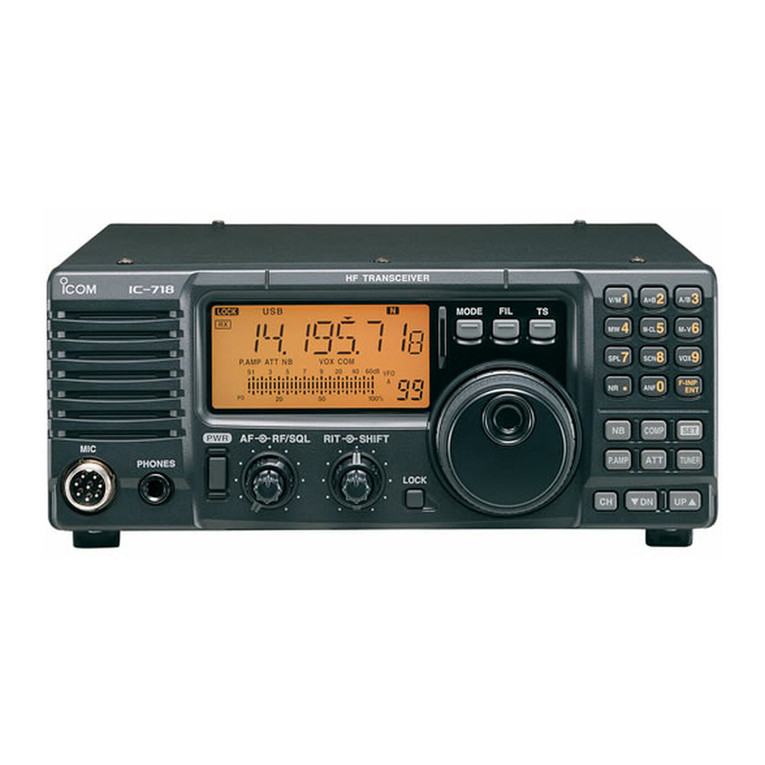
Icom
Icom IC-718 User manual
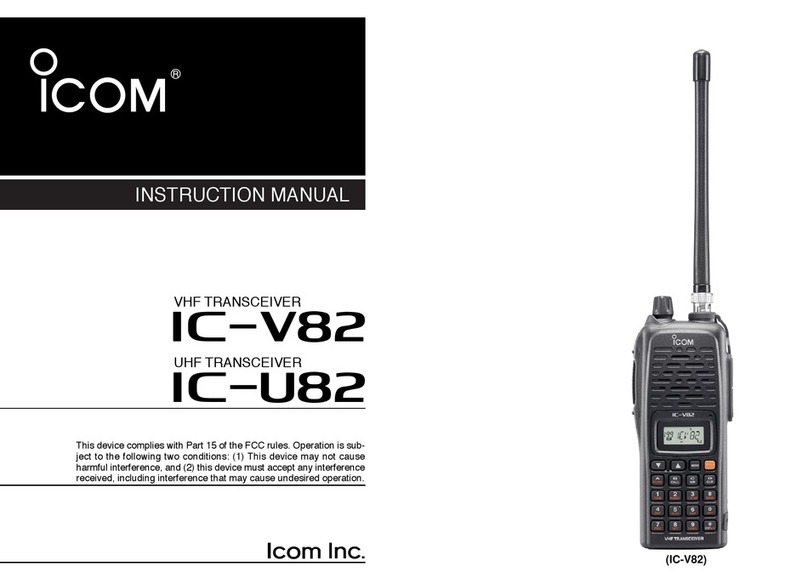
Icom
Icom IC-V82 User manual

Icom
Icom IC-7300 Installation instructions
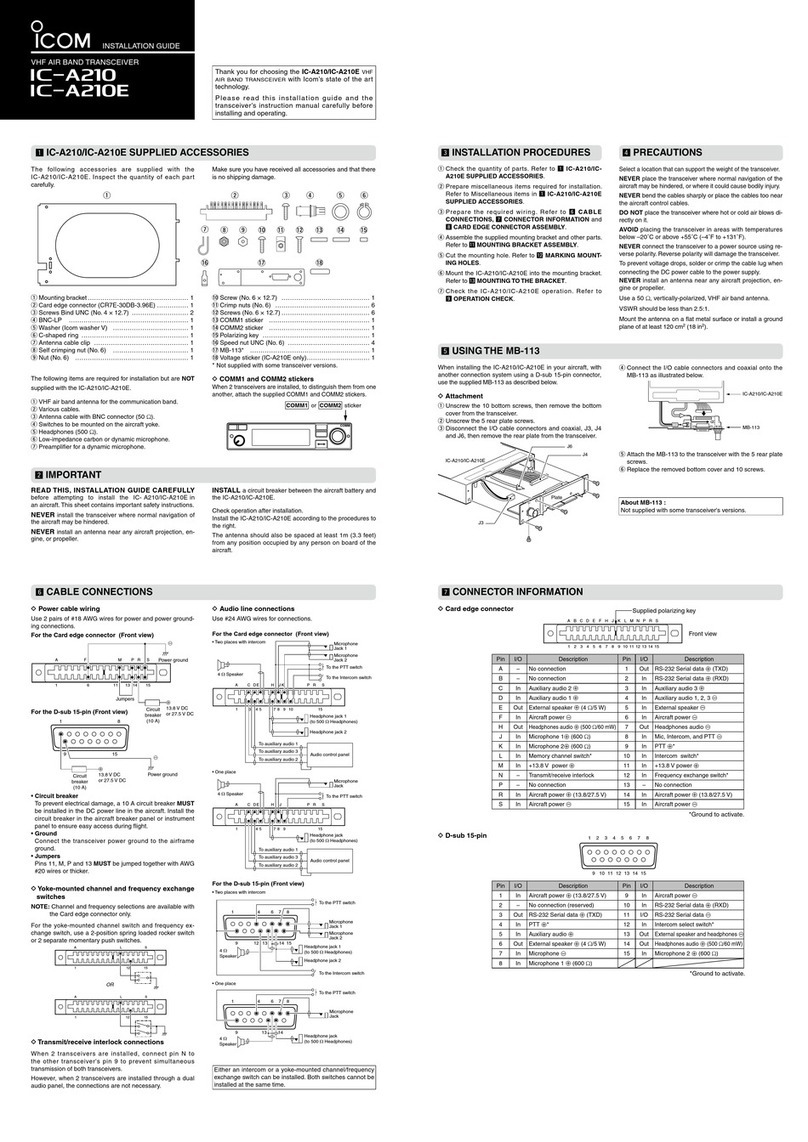
Icom
Icom IC-A210 User manual
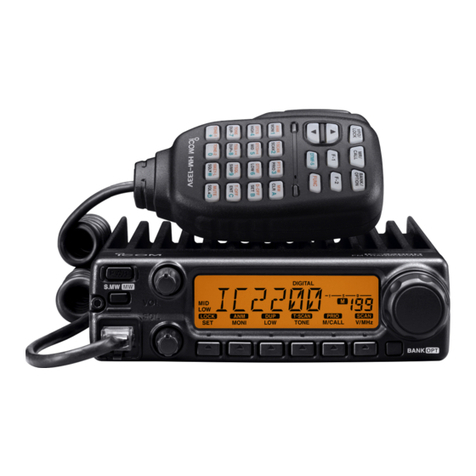
Icom
Icom IC-2200H User manual
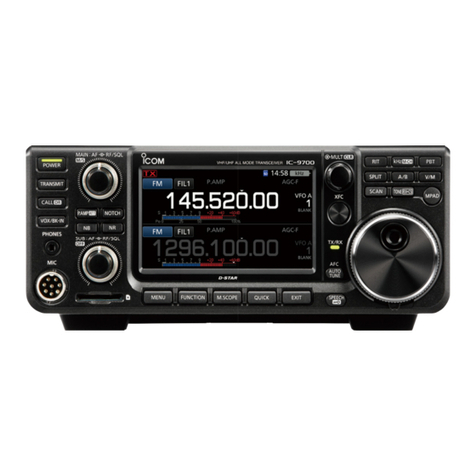
Icom
Icom IC-9700 Installation guide

Icom
Icom IC-77 User manual
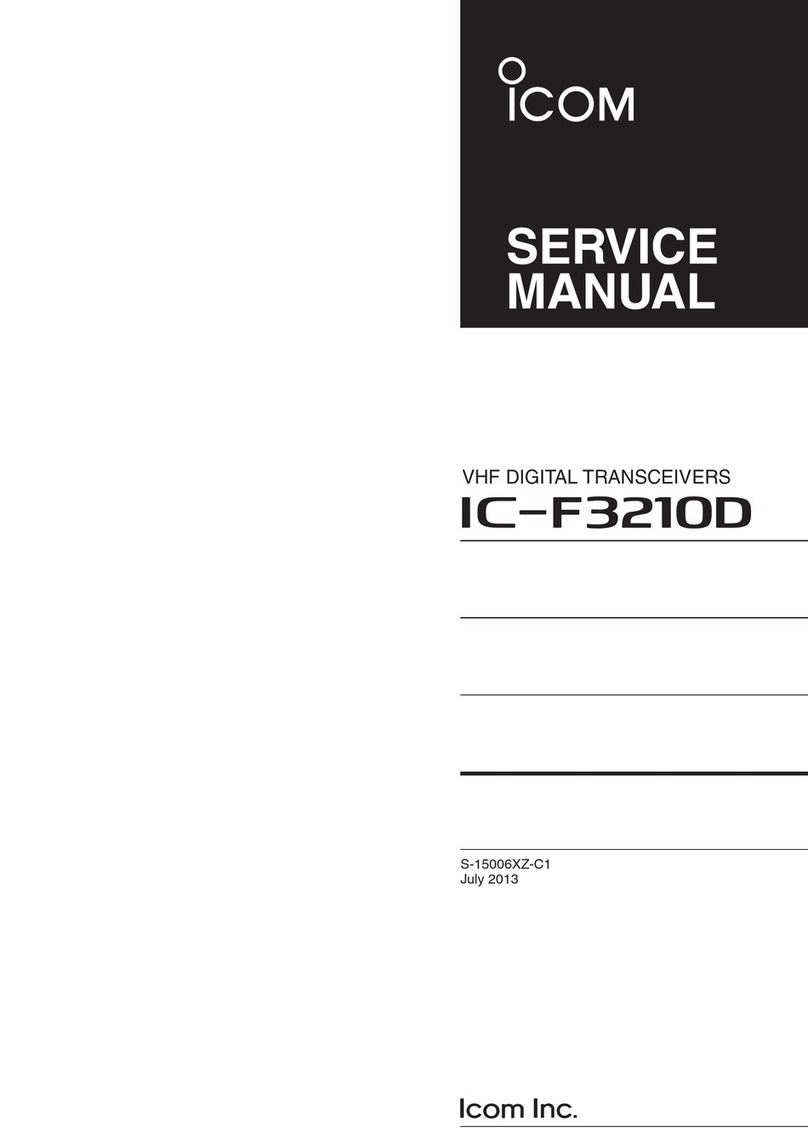
Icom
Icom IC-F3210D Series User manual

Icom
Icom IC-80AD User manual
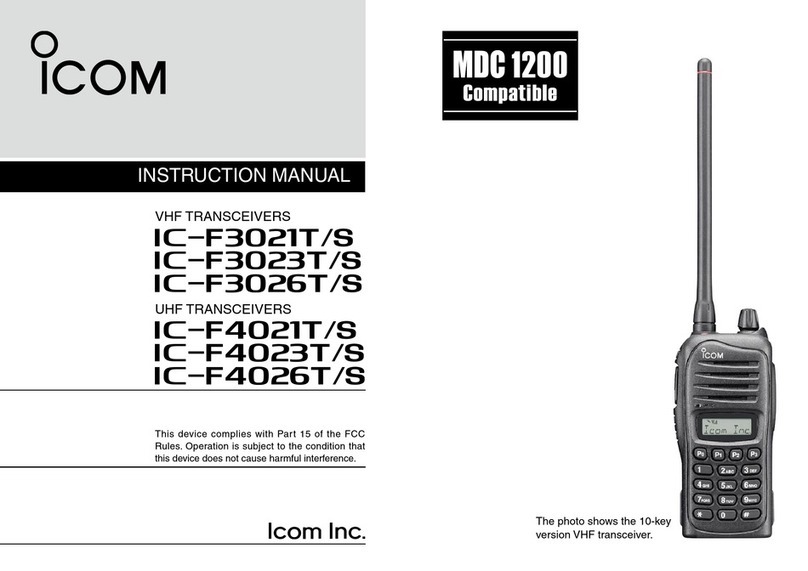
Icom
Icom IC-F3021T/S User manual
Popular Transceiver manuals by other brands

SG Security Communications
SG Security Communications SKYROUTE installation manual
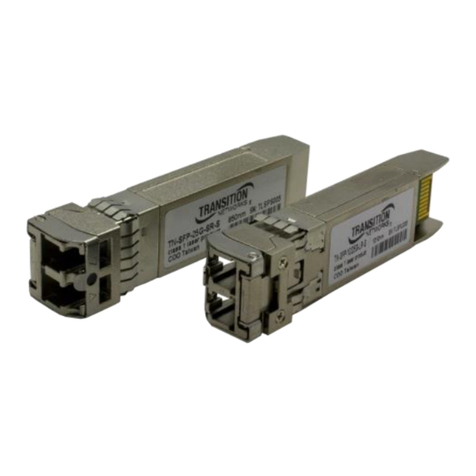
Transition
Transition TN-SFP Series user guide

Vertex Standard
Vertex Standard Spirit VXA-700 operating manual
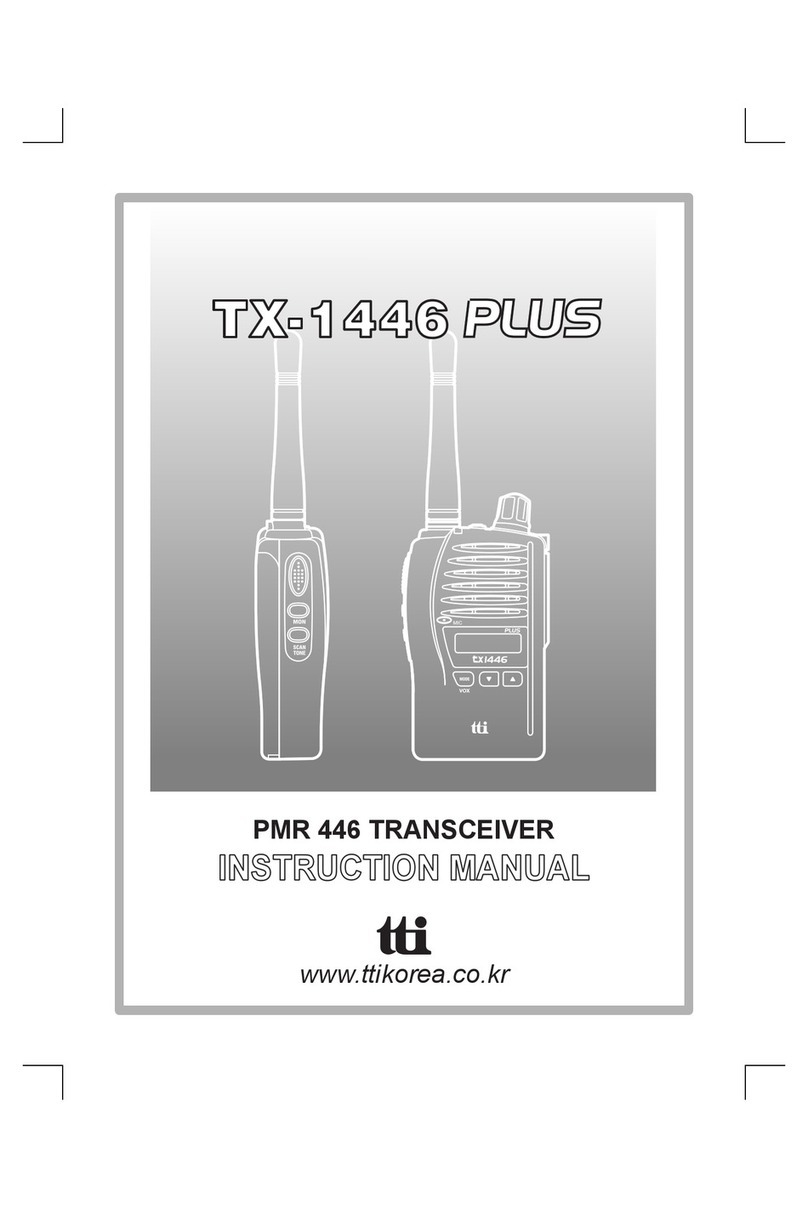
TTikorea
TTikorea TX-1446 PLUS instruction manual
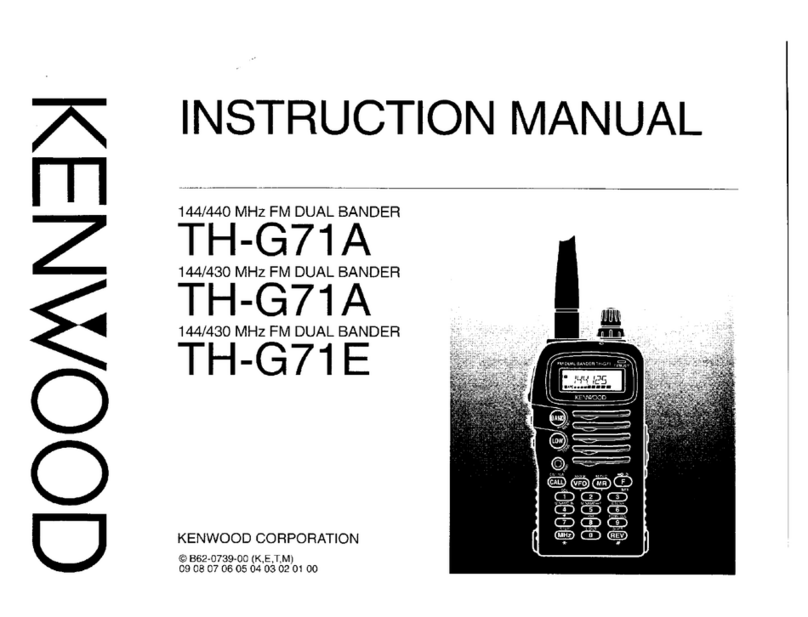
Kenwood
Kenwood TH-G71A instruction manual
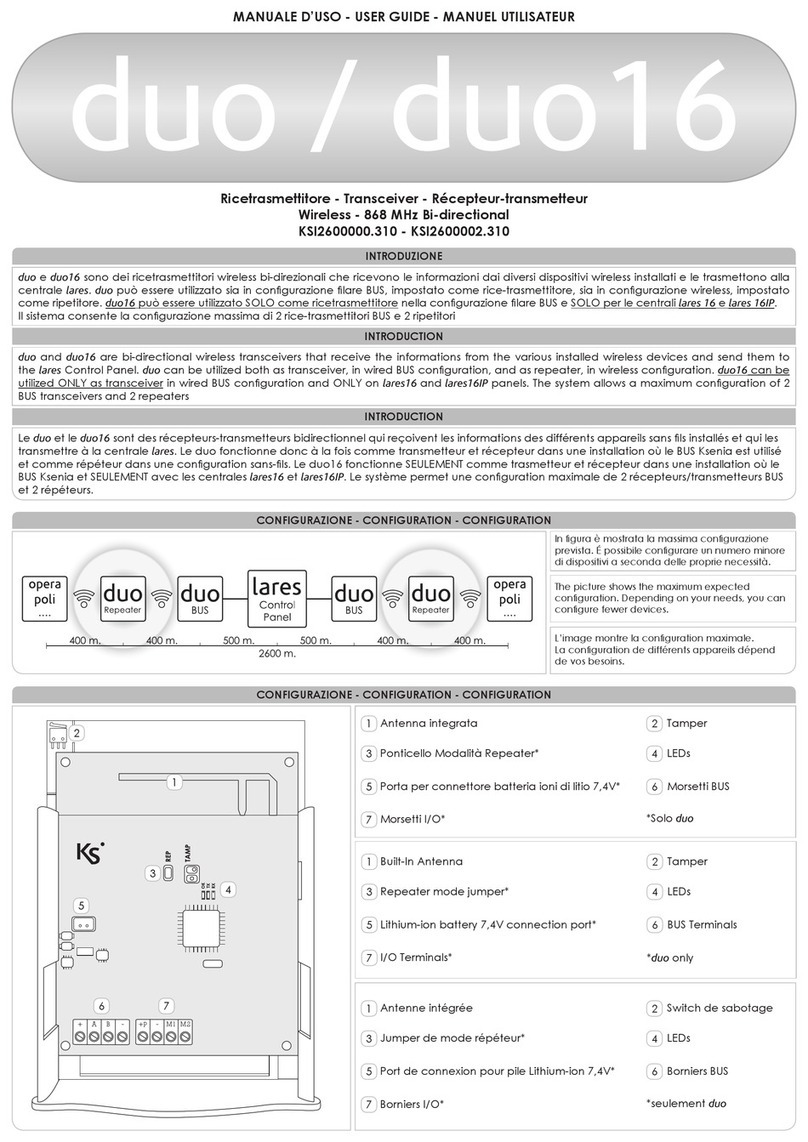
Ksenia
Ksenia duo user guide
